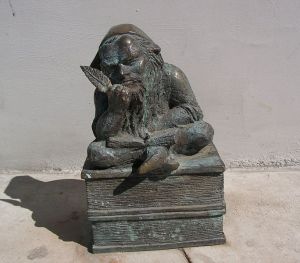I’ve recently found myself in a writing critique group that has made me think about medieval/D&D-type fantasy kindreds in the context of the classical world. Specifically, what would you call such beings if you were discussing them not in English (or any other northern European language) but in Greek?
The short answer: It isn’t as easy as it looks, but there are some options.
Steven A. Guglich’s Veil Saga is shaping up to be a centuries-spanning tale of magic and intrigue. The bit of it that I’ve been reading/critiquing lately takes place in the fourth century AD, which means the characters are discussing elves, goblins, etc., in the language of that time and place: namely, Koine Greek. (Koine Greek is halfway between the Classical Greek of Socrates and the Byzantine Greek of the Middle Ages.) I’m thoroughly enjoying the tale, but the language nerd in me wants to know: How does one say “elf” (or goblin, or whatever) in Greek?
Here are my thoughts.
Dwarf
Let’s start with the easiest one. A dwarf is a νᾶνος (nanos). That term can be applied both to someone with the physical condition of dwarfism as well as to the mythological creature. If you wanted a term that exclusively referred to a mythological creature, I’d vote for δάκτυλος (daktylos), a race of rustic nature spirits who were skilled in metal-working.
Goblin
The closest I can get is μορμώ (mormo, plural mormones), meaning “fearful ones” or “hideous ones.” This is the term for a Greek bogey-woman. A more fearful version might be a μορμολυκεῖον (mormolykeion) or “wolf-bogey.”
There are a couple of other options here, though. A κόβαλος (kobalos, whence we get “kobold”), for example, is a roguish, gnomish sort of being, a shapeshifting companion of the god Dionysus. If you’re looking for a good Greek word for “kobold” or “gnome,” you can scarcely go wrong with kobalos.
A bit further afield, a κέρκωψ (kerkops) is a thieving, monkey-like creature. In mythology, there were only two of them, but the image might fit the bill depending on what your goblins are like.
Elf
This is where I started my musing, and it is in some ways the most difficult to pin down, mainly because people have different ideas about what elves actually are (mythologically speaking).
If you imagine elves as faery woodland creatures cavorting in a meadow, then you can’t go wrong with either σάτυρος (satyros) or πάν (pan) for a male and νύμφη (nymphe) for a female. (And yes, Greeks would use pan, plural panes, as a common noun.)
In English lore, elves, fairies, and nymphs and satyrs were all pretty much the same thing. Loads of Old English translations of Greek and Roman classics translated Greek σάτυρος or Latin faunus as aelf, “elf.”
At the same time, when Greek-speakers became more aware of the legends of their northern neighbors, they coined a new term for these fairy beings to distinguish them from those in their own mythology. In Byzantine Greek, such a being was called a χοτικό (xotiko), from earlier ἐχοτικόν (exotikon), literally “outlandish thing.” If the characters in Steven’s story are using this word in the fourth century, they are among the very first to do so.
If, however, you think of elves as more like friendly toymakers than eldritch wonders, you’ll probably have to default to nanos. If the most important distinguishing characteristic of elves in your mind is their diminutive size, you might want to consider…
Halfling
The Greeks did have a word for a very small humanoid: πυγμαῖος (pygmaios) or “pygmy.” This comes from the word for cubit, a length of about 18″—although pygmies weren’t always that short in mythology. As I noted in a previous post, the term “pygmy” has some unfortunate baggage that makes it largely unusable in modern English. But for Greek-speakers in the ancient world, you might be able to get away with it.
So, if elves or goblins ever use their magic to send you back to ancient times, you can use this handy cheatsheet to explain your predicament to bystanders. You’re welcome.






